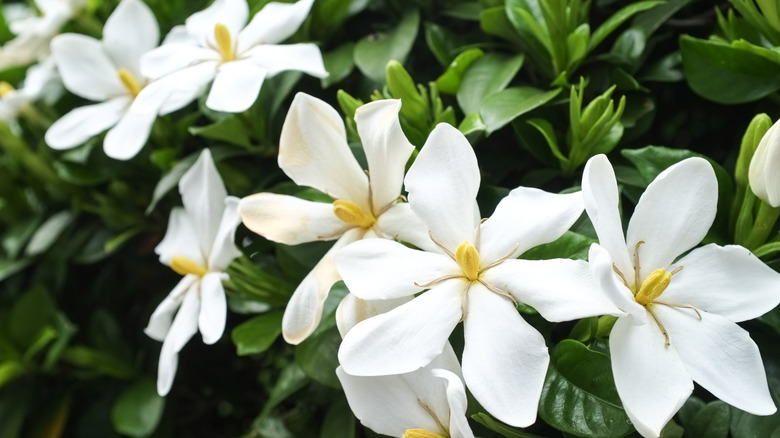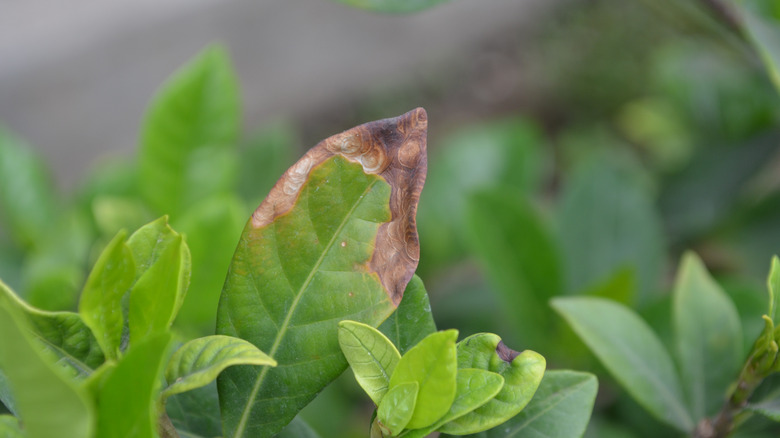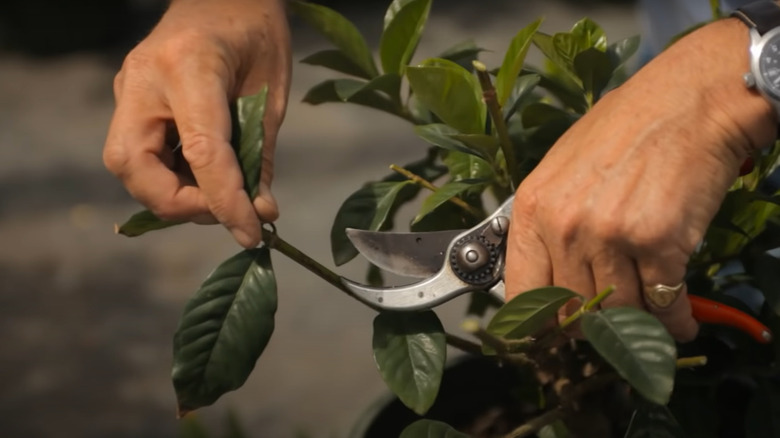Mistakes To Avoid If You Want Healthy Gardenias In The Garden
A Southern staple, gardenias are notorious for leaving gardeners breathless (literally!) with their intoxicating, sweet aroma. Their glorious, sometimes lilac-mottled, creamy white inflorescence contrasted against emerald green foliage adds to their allure. In addition to their charm, these garden divas aren't without their high maintenance needs. Such specific growth requirements, however, open doors to several mistakes, like overwatering, inadequate sun exposure, and poor fertilization practices, severely harming the perfumed blooms. Their after-effects often include leggy stems, yellow leaves, bud drop, and stunted plant growth.
Although gardenias as a whole are finicky, their roots are another ball game. Sticklers of acidic soils with pH levels between 5 and 6.5, these evergreen shrubs show you the door in lime-containing, basic soils (soil with a pH greater than 7), unless you make peace with growing gardenias in containers. Keen on spreading their shallow roots far and wide, they demand ample space, driving out competition. Besides, they loathe transplantation, so planting them in the wrong spot is the first mistake to avoid — raised beds are the right call for brown thumbs, as it affords correcting planting mistakes.
Overwatering and poor drainage are major slip-ups
Acing the acidity test isn't sufficient to coax your gardenias into displaying their ornamental beauty; balancing their relationship with water is a must, too. The evergreen shrubs enjoy moist soils, but abhor drenched feet. Excessive watering can cause the green, unripe buds to drop off prematurely, leading to a poor show during flowering. Fungal diseases like root rot, powdery mildew, and cankers are a bother, as they thrive in wet roots. To stave them away, maintain the right irrigation schedule and ensure adequate drainage.
Without rainfall, soak gardenias weekly in 1 inch of water — use even more water during drought. If unsure of when you should water next, conduct a finger test, checking that the top inch isn't dry to the touch at any time between soakings. While at it, avoid getting water over the foliage, lest it develop leaf spot, a vicious bacterial disease that covers the leaves in circular, tan spots. At the same time, avoid using salt-rich or reclaimed water to achieve the healthiest growth. Instead of cultivation, improve drainage by mulching plants with compost, bark, pine needles, and other organic matter, going at least 2 to 3 inches deep.
Fall fertilization, insufficient sunlight, and poor pruning practices are gardenia no-nos
Mulching doesn't discount the need for fertilization, given these flowering plants' propensity to suffer iron deficiencies, causing yellowing shrubbery. Treating them to chelated iron becomes a requisite, in addition to routinely applying a slow-release, balanced azalea fertilizer at least two to three times a year. Just be sure to avoid fall fertilization, as it stimulates new growth in overwintering gardenias, exposing them to winter injury. That being said, given their tropical lineage, gardenia plants enjoy their fair share of sunbathing. So, don't make the mistake of placing them in shaded spots unless you want to be stuck with small blooms. Instead, keep the multi-stemmed shrubs in full or partially sun-lit areas.
However, gardeners living in USDA zones 8 and above must provide sun protection during the midday highs to prevent the plants from scorching under intense heat. In their zest for higher spring blooms, many erroneously indulge in hard pruning practices during the fall, which doesn't bode well for your broadleaf beauties. Although gardenias can be shaped throughout flowering, you must wait for the last blooms to wither out (mid-summer) before carrying out any major pruning. While the schedules will vary depending on the growth zones, pruning after October is generally looked down upon because the perennials already support new buds that will eventually bloom next year. Moreover, removing damaged branches improves air circulation, keeping powdery mildew and pests at bay.


